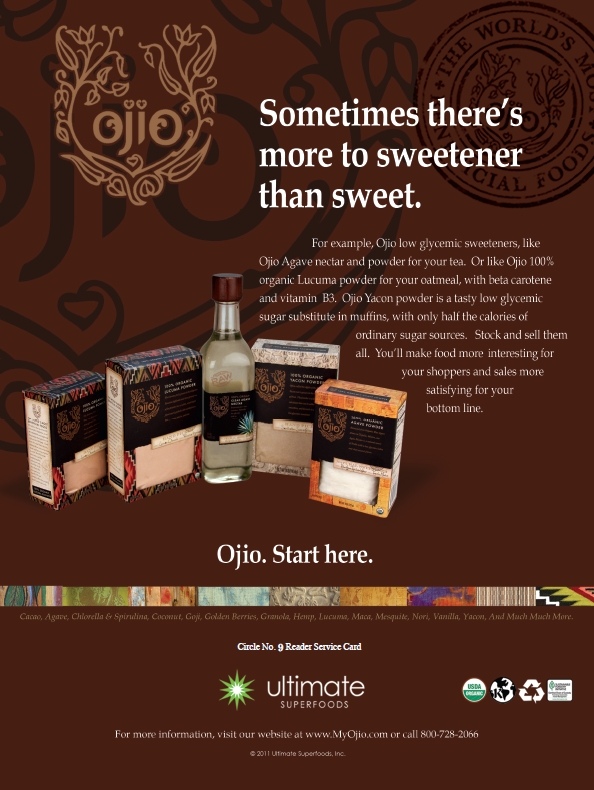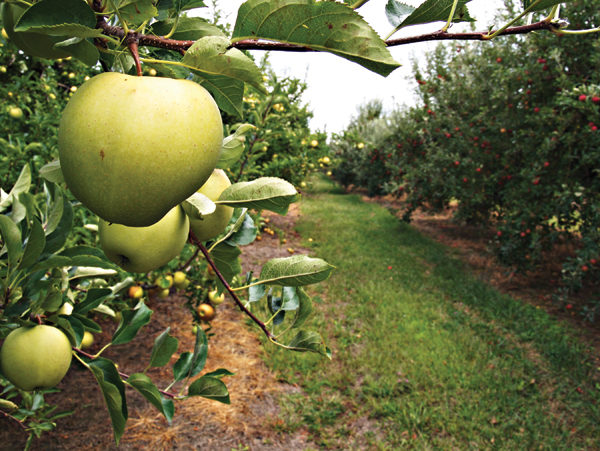The organic industry is perhaps one of the most dynamic markets in the food industry today, as it grew 8% in 2010 to $28.6 billion in sales even during a down economy (1).
While sales are climbing, so too is confusion about organic. Many shoppers still don’t understand what it takes to be called organic, what the tiered U.S. Department of Agriculture (USDA) symbols mean and what exactly makes organic products better than their conventional counterparts. To keep shoppers in the know, it’s important for retailers to have hard facts about why spending extra for organic is worth it.
Is Organic Really Healthier?
 Many consumers would love to see a nutritional comparison of organically and conventionally grown produce, and new research may help. In fact, these “matched pairs” studies often compare the same seed/plant variety grown using various methods. Says Neil E. Levin, nutrition education manager at NOW Foods, Bloomingdale, IL, “In these studies, the organics dominate the highest measures of nutrients over the identical type of non-organic crops. Additionally, the inclusion of nutrients beyond the traditional vitamins and minerals, notably polyphenols and other antioxidants, in more recent studies increases the number of cultivars and studies with better scores for organic foods.”
Many consumers would love to see a nutritional comparison of organically and conventionally grown produce, and new research may help. In fact, these “matched pairs” studies often compare the same seed/plant variety grown using various methods. Says Neil E. Levin, nutrition education manager at NOW Foods, Bloomingdale, IL, “In these studies, the organics dominate the highest measures of nutrients over the identical type of non-organic crops. Additionally, the inclusion of nutrients beyond the traditional vitamins and minerals, notably polyphenols and other antioxidants, in more recent studies increases the number of cultivars and studies with better scores for organic foods.”
One 2010 study published in PLoS One compared strawberries grown on side-by-side organic and conventional farms. While the non-organic farm produced a larger fruit, the flavors and nutrients were diluted. The organic variety was 15% smaller, but contained more antioxidants and vitamin C for the size (2).
Also noteworthy is that the 2008–2009 President’s Cancer Panel Report believes pesticides exposure increases one’s risk of cancer. The report speaks of research on children of conventional farmers, who were exposed to pesticides regularly. Sadly, these children were more likely to have leukemia, so the report recommends that Americans invest in food grown without chemicals (like organic).
“We know more today about the effects of pesticides, hormones and chemicals in our bodies and on our Earth than we’ve ever known before,” says George L. Siemon, founding farmer and “C-E-I-E-I-O” of Organic Valley, LaFarge, WI. “Our children, and even infants in utero, are exposed to so many elements that are potentially responsible for autism, diabetes, heart disease, endocrine disruption and a host of health and behavioral issues that are chronic and impact quality of life, if not fatal. We used to talk about organics as a choice issue for adults. But now that we know it affects the lives of children not born, we have to advocate against the chemical industrial model at all levels.”
With so many children affected by problems like attention deficit disorder, families are dying for answers about what causes it. While no conclusive evidence has been found, many industry members  are interested in new data showing a link between pesticides and problems in cognitive development. A ground-breaking 2010 study found that children who had the highest levels of organophosphate pesticides in their urine were the most likely to develop attention deficit and hyperactivity disorder (3).
are interested in new data showing a link between pesticides and problems in cognitive development. A ground-breaking 2010 study found that children who had the highest levels of organophosphate pesticides in their urine were the most likely to develop attention deficit and hyperactivity disorder (3).
“Several new studies have confirmed that exposures via the diet to organophosphate insecticides are impairing cognitive development, shaving four to seven points off average IQs among children born to mothers exposed during pregnancy,” according to Charles Benbrook, The Organic Center’s chief scientist. He adds, “It turns out that exposures to pesticides in the early stages of fetal development can block or disrupt gene expression in ways that lead to abnormal metabolism later in life, raising the risk of overweight, obesity and diabetes.”
This summer, researchers found that that for every 10-fold increase of organophosphate pesticide in a pregnant woman’s urine, her child’s IQ score dropped by five points. Children with the highest levels of prenatal pesticide exposure averaged seven points lower on a standardized intelligence test than kids with the least exposure (4).
Says Benbrook, “Hopefully these new studies will compel the Environmental Protection Agency to phase out tolerances allowing high-risk uses of these insecticides to continue.”
Can I Skip Some Organic Foods?
Consumers may feel that to save a little off the grocery budget, it’s smart to pass up thick-skinned produce like organic bananas since the inner fruit is protected. Though the validity of this tip is debatable, one can also make the case that it fails to take into account the environmental aspect of eating organic.
Levin speaks of a 22-year study conducted by the Rodale Institute, the U.S. Department of Agriculture (USDA) and the University of Maryland that examined various aspects of organic farming including crop yields, costs, energy efficiency, nitrogen accumulation and more (5). According to Levin, “Organic farming produced the same yields of corn and soybeans as did conventional farming, but used 30% less energy, less water and no pesticides.”
Also, the researchers found soil degradation on the  conventional farm thanks to wind and water erosion. Conversely, “organic farms steadily improved in organic matter, moisture, microbial activity and other soil quality indicators. In the drought years, 1988 to 1998, corn yields in the organic, legume-based system were 22% higher than yields for corn in the conventional system,” says Levin.
conventional farm thanks to wind and water erosion. Conversely, “organic farms steadily improved in organic matter, moisture, microbial activity and other soil quality indicators. In the drought years, 1988 to 1998, corn yields in the organic, legume-based system were 22% higher than yields for corn in the conventional system,” says Levin.
Other work from the Rodale Institute points to great benefits in reducing global warming. According to Laura Batcha, chief of policy and external relations for the Organic Trade Association, Brattleboro, VT, “Not only does [organic agriculture] build nutrient-rich soil and help to keep our water supplies clean, it also removes carbon dioxide from the air and sequesters it.”
Batcha cites Rodale Institute data indicating organic farming removes about 7,000 pounds of carbon dioxide from the air per year. She adds, “Accordingly, if all 434 million acres of U.S. cropland were converted to organic practices, it would be the equivalent of eliminating 217 million cars—nearly 88% of all cars in the country today and more than a third of all the automobiles in the world!”
Why Should I Care about GMOs If I Buy Organic?
Proponents of genetically modified organics (GMOs) believe their chemically altered plants are valuable because they increase crop yield. But, the problem is that the effects of these crops on humans and the environment have not been thoroughly tested.
GMO crops can easily contaminate non-GMO farms. Says Levin, “The dangers of these genetics spreading beyond the target crop are significant, as are the nutrient and agricultural deficits of most present GMO crops. The organic and non-GMO farmers suffer when their crops are contaminated by uncontrolled pollen spread.” Recently the biotech industry got a boost when the USDA decided to allow the planting of Roundup Ready genetically modified alfalfa, sugar beets and feed corn.
GMO products don’t require labeling, “so consumers cannot make choices in the market place. The USDA’s decisions can only renew our commitment to fight GMOs. This will be a lifelong struggle for many of us, and one that we can never give up on,” says Siemon.
One way to ensure a GMO-free product is to buy organic, but even this industry may experience some unintended effects from GMOs. “The consumer is an important part of the equation here…[Avoiding GMOs is] one of the biggest reasons people buy organic, and dairy is the most commonly purchased organic food group after produce. Without the assurance that organic foods are free of GMOs, consumers will have fewer reasons to buy, which will strike a blow to organic farmers and the entire organic industry,” states Albert Straus, organic dairy farmer and president of Straus Family Creamery, CA.
Adds Todd J Kluger, vice president of marketing at Lundberg Family Farms, Richvale, CA, “The deregulation of certain GMO crops, like alfalfa, affect the organic farmer by making it seem the GMOs are acceptable to the general public.”
Straus aptly hinted at the plight of organic dairy farmers, who feed their cows organic alfalfa. Some fear that a preponderance of GMO alfalfa in the market could make it tough to get the non-GMO feed supply they need. “We’ve been worried about feed contamination for a long time now and, in 2006, became the first organic dairy to voluntarily test our organic feed for genetically modified material,” says Straus.
Benbrook points out, too, that the Organic Valley Cooperative is a main force in helping organic dairy farmers secure GMO-free alfalfa. He believes that a “very strict alfalfa seed purity threshold can be met” if there’s a concerted effort to plant non-GM alfalfa far from GM alfalfa. Such an initiative, says Benbrook, could increase costs and reduce the variety of seeds available to organic farmers. But in time, the supply should be there. “For this to happen,” he feels “the organic community needs to come together to speak with one voice regarding the testing requirements needed to designate seed as GE-clean. A unified position is very important to create enough seed market demand to justify new investments by seed companies.”
Kluger says retailers can make sure shoppers understand this issue with good consumer education, which includes “clear labeling of products that contain GMO ingredients, not just those that don’t contain them.”
Stores can also offer information about the Non-GMO Project (www.nongmoproject.org). According to Kluger, whose company was a founder, “The Non-GMO Project supplies a label to those products that can verify that they do not contain GMOs.” Therefore, shoppers can be assured that what they’re buying doesn’t contain GMOs. Straus adds that shoppers can also support the Center for Food Safety and take action through their campaigns: http://truefoodnow.org/campaigns/genetically-engineered-foods.
Companies like Organic Valley are also taking the fight against GMOs into their own hands. Says Siemon, “We are pledging a significant financial support and staff time to try and turn this threatening tide. We are actively funding and advocating for:
• mandatory labeling of products containing GMOs.
• supporting legal efforts challenging the RR-alfalfa and sugar beet EISs and future GMO crops.
• compensation for organic farmers if they are contaminated.
• demand the USDA open their evaluation to sources outside of biotech’s own research.
• to implement regulatory controls that are designed for biotechnology and address all our concerns.”
Could the 2012 Farm Bill Affect the Organic Industry?
Budgets are tight everywhere, and this includes the USDA. Batcha states, “It could be an uphill battle to get such support as members of Congress are warning that there will be limited funding for the next Farm Bill.”
Nonetheless, Kristen Holt, a member of OTA’s board, testified at the Senate Agriculture Committee’s first Farm Bill field hearing, held May 31 in Michigan, according to Batcha. The following requests were made:
• More funding for the National Organic Program (NOP).
• Funding for organic research.
• Funding for the organic certification cost-share program.
• Assistance to organic producers for conservation practices.
• Improving crop insurance for organic crops.
But unfortunately, it could be tough for Congress to allot such funding for these initiatives.
If the agency’s budget is reduced further, some subsidies for conventional farms may go by the wayside. Benbrook believes they would pass higher costs on to consumers. The upshot, he feels, is that when prices normalize, companies will have no other choice but to adopt more efficient systems.
Regarding the 2012 fiscal year budget, Batcha says, “We face a huge challenge to fight for organic funding amid massive cuts to the 2012 budget.” To date, the House Appropriations Committee has slashed USDA/FDA’s discretionary spending by $2.7 billion. She says the working plan is to fund the NOP at the same level as fiscal year 2011 (or more), give $4 million for organic research and $2 million for Appropriate Technology Transfer for Rural Areas.
What’s Hot in Organic?
Savvy retailers will want to be sure they are stocking exactly what shoppers want. First, consider produce. As previously mentioned, organic fruits and vegetables experienced the most growth in 2010.
Citing the OTA’s 2010 Organic Industry Survey, Batcha says this segment represents “39.7% of total organic food value, and nearly 12% of all U.S. fruit and vegetable sales, reached nearly $10.6 billion in 2010, up 11.8% from 2009 performance.”
David Rosenberg, NOW Foods’ food category manager calls organic produce a “gateway segment.” The reason why, he feels, is that “Consumers see the most benefit and differentiation here and perceive organic produce to be fresher, higher quality, and more nutritious. Price differentials between some organic items and their conventional counterparts, such as apples and carrots, have narrowed.”
Nonetheless, some items are still too expensive because of limited availability, he says. Thus, crossover shoppers may not fork over the extra cash for these organics and choose conventional. Rosenberg sees this as an opportunity for mainstream retailers, so organic stores should up their educational efforts about why organic is the best deal for the body and the environment.
And, keep your eye on the organic dairy market, too. Says Batcha, “Organic dairy, the second-largest category, experienced 9% growth to achieve a value of $3.9 billion, and captured nearly 6% of the total U.S. market for dairy products.”
On this front, Siemon feels that omega-fortified dairy products are an area of interest. “We are very excited about the importance of omega-3s in our diets, and leveraging healthful foods for prevention,” he says, adding, “We are exploring through our production practices (feedstuff and pasturing) how to increase them naturally.”
Other areas of growth, according to Rosenberg, include organic functional foods. “Many of these foods are good substitutes for supplements as consumers look to receive these benefits from the foods they eat,” he says, listing among them coconut oil, olive oil, nuts and seeds, nutrition bars, bread and nut butters.
Last, staples like organic grains, nuts and sweeteners may be on the up and up. Be it organic brown rice, quinoa, sugar, walnuts, flax or dry milk, Rosenberg sees these mainstays as manageable ways for uncertain shoppers to increase the amount of organic foods in their diets. WF
References
1. Organic Trade Association, “U.S. Organic Industry Valued at Nearly $29 Billion in 2010,” press release distributed April 21, 2011, www.organicnewsroom.com/2011/04/us_organic_industry_valued_at.html
2. J.P. Reganold et al., “Fruit and Soil Quality of Organic and Conventional Strawberry Agroecosystems,” PLoS ONE 5 (9), e12346.
3. M.F. Bouchard et al., “Attention-Deficit/Hyperactivity Disorder and Urinary Metabolites of Organophosphate Pesticides,” Pediatr. 125(6), e1270–1277 (2010). Epub May 17, 2010.
4. M.F. Bellinger et al., “Prenatal Exposure to Organophosphate Pesticides and IQ in 7-Year Old Children,” Environ. Health Perspect. (2011).
5. D. Pimentel et al., “Environmental, Energetic, and Economic Comparisons of Organic and Conventional Farming Systems,” BioScience 55 (7), 573–582 (2005).
Published in WholeFoods Magazine, August 2011










